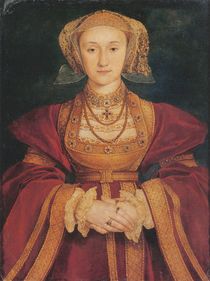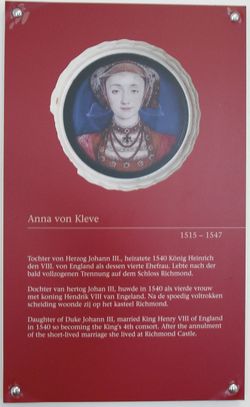Anne of Cleves
| Anne of Cleves | |
|---|---|
 |
|
| Portrait by Hans Holbein the younger, 1539. Parchment mounted on canvas, Louvre, Paris. | |
|
|
|
| Tenure | 6 January 1540 – 9 July 1540 |
| Spouse | Henry VIII of England |
| Father | John III, Duke of Cleves |
| Mother | Mary, Duchess of Jülich-Berg |
| Born | 22 September 1515 Düsseldorf, Duchy of Berg |
| Died | 16 July 1557 (aged 41) Hever, Kent, England |
| Signature | |
| Religion | Raised Lutheran, Anglican on marriage, Catholic at death |

Anne of Cleves (German: Anna von Jülich-Kleve-Berg) (22 September 1515 – 16 July 1557) was a German noblewoman and the fourth wife of Henry VIII of England and as such she was Queen of England from 6 January 1540 to 9 July 1540. The marriage was never consummated, and she was not crowned queen consort. Following the annulment of their marriage, Anne was given a generous settlement by the King, and thereafter referred to as the King's Beloved Sister.
Anne was the subject of two portraits by Hans Holbein the younger who painted her in 1539.
Contents |
Early life
Anne was born in 1515 near Düsseldorf,[1] the second daughter of John III, Duke of Jülich jure uxoris, Cleves, Berg jure uxoris, Count of Mark and Ravensberg jure uxoris (often referred to as Duke of Cleves) who died in 1538, and his wife Maria, Duchess of Julich-Berg (1491–1543). She grew up living in Schloss Burg on the edge of Solingen. Anne's father was influenced by Erasmus and followed a moderate path within the Reformation. He sided with the Schmalkaldic League and opposed Emperor Charles V. After John's death, Anne's brother William became Duke of Jülich-Cleves-Berg, bearing the promising epithet "The Rich." In 1526, her elder sister Sybille was married to John Frederick, Elector of Saxony, head of the Protestant Confederation of Germany and considered the "Champion of the Reformation."
At the age of 12 (1527), Anne was betrothed to Francis, son and heir of the Duke of Lorraine while he was only 10, thus the betrothal was considered 'unofficial' and was cancelled in 1535. Her brother William was a Lutheran but the family was unaligned religiously, with her mother, the Duchess Maria described as a "strict Catholic."[2] The Duke's ongoing dispute over Gelderland with Emperor Charles V made them suitable allies for England's King Henry VIII in the wake of the Truce of Nice. The match with Anne was urged on the King by his chancellor, Thomas Cromwell.
Wedding preparations
The artist Hans Holbein the Younger was dispatched to paint portraits of Anne and her younger sister, Amelia, both of whom Henry was considering as his fourth wife. Henry required the artist to be as accurate as possible, not to flatter the sisters. The two versions of Holbein's portrait are in the Louvre in Paris and the Victoria and Albert Museum in London. Negotiations with Cleves were in full swing by March of 1539. Cromwell oversaw the talks, and a marriage treaty was signed on 4 October of that year.
Henry valued education and cultural sophistication in women, but Anne lacked these: she had received no formal education but was skilled in needlework and liked playing card games. She could read and write, but only in German. Nevertheless, Anne was considered gentle, virtuous, and docile, qualities that made her a suitable candidate for Henry.
Anne was described by the French ambassador, Charles de Marillac, as tall and slim, "of middling beauty, and of very assured and resolute countenance".[3] She was dark haired, with a rather swarthy complexion, appeared solemn by English standards, and looked old for her age. Holbein painted her with high forehead, heavy-lidded eyes and a pointed chin.[4]
| The Six Wives of Henry VIII |
|---|

Henry was impatient to see his future bride. He went to meet her at Rochester and was promptly disappointed. He felt he had been misled, for everyone had praised Anne's attractions: "She is nothing so fair as she hath been reported," he complained.[6] Henry urged Cromwell to find a legal way to avoid the marriage but, by this point, doing so was impossible without endangering the vital alliance with the Germans.
A doomed marriage
Despite Henry's very vocal misgivings, the two were married on 6 January 1540 at the royal Palace of Placentia in Greenwich, London by Archbishop Thomas Cranmer. The phrase "God send me well to keep" was engraved around Anne’s wedding ring. Immediately after arriving in England, Anne conformed to the Anglican form of worship, which Henry expected.[7] The couple's first night as husband and wife was not a happy one. Henry confided to Cromwell that he had not consummated the marriage, saying, "I liked her before not well, but now I like her much worse".[8]
Anne was commanded to leave the Court on 24 June, and on 6 July she was informed of her husband's decision to reconsider the marriage. Shortly afterwards, Anne was asked for her consent to an annulment, to which she agreed. The marriage was annulled on 9 July 1540, on the grounds of non-consummation and her pre-contract to Francis of Lorraine.
After the annulment
The former queen received a generous settlement, including Richmond Palace, and Hever Castle, home of Henry's former in-laws, the Boleyns. Anne of Cleves House, in Lewes, Sussex, is just one of many properties she owned; she never lived there. Henry and Anne became good friends—she was an honorary member of the King's family and was referred to as "the King's Beloved Sister". She was invited to court often and, out of gratitude for her not contesting the annulment, Henry decreed that she would be given precedence over all women in England save his own wife and daughters.[7]
After Catherine Howard was beheaded, Anne and her brother, the Duke of Cleves, pressed the king to remarry her. Henry quickly answered such suggestions with a no.[9]
In 1553, when Henry's daughters Mary and Elizabeth rode into London with Mary as the new monarch, Anne was there to greet them.[7] She was also present at Mary I's coronation at Westminster.[7] That was her last public appearance. As the new Queen was a strict Catholic, Anne yet again converted her religion, now to becoming a Roman Catholic.
A few months later, Anne wrote to Mary I to congratulate her on her marriage to Philip of Spain.[7] Nevertheless, Anne rarely visited the Court during Mary's reign and enjoyed managing her own estates.[7] Since her arrival as the King's bride, Anne had never left England: both of her parents had died by the time her marriage was annulled and her brother, a strict Lutheran, did not approve of her adherence to Anglicanism.[7]
Death
When Anne's health began to fail, Mary I allowed her to live at Chelsea Old Manor, where Henry's last wife, Catherine Parr, had lived after her remarriage. Here, in the middle of July 1557, Anne dictated her last will. In it, she mentions her brother, sister and sister-in-law, as well as the future Queen Elizabeth, the Duchess of Norfolk and the Countess of Arundel.[7] She left some money to her servants and asked Mary and Elizabeth to employ them in their households.[7]
Anne died at Chelsea Old Manor on 16 July 1557, a few weeks before her forty-second birthday. The cause of her death was most likely to have been cancer.[10] She was buried in Westminster Abbey, on 3 August, in what has been described as a "somewhat hard to find tomb" - on the opposite side of Edward the Confessor's shrine and slightly above eye level for a person of average height. She is the only wife of Henry VIII to be buried in the Abbey.
She also has the distinction of being the last of Henry VIII's wives to die (she outlived Henry's last wife, Catherine Parr, by 9 years). She was not the longest-lived, however, since Catherine of Aragon was 50 at the time of her death and Anne only 41.
Non fiction
Anne is the subject of two biographies: Elizabeth Norton's Anne of Cleves: Henry VIII's Discarded Bride and Mary Saaler's Anne of Cleves. Retha Warnicke has written a study on Anne's marriage called The Marrying of Anne of Cleves.
Lineage
| Ancestors of Anne of Cleves | ||||||||||||||||||||||||||||||||||||||||||||||||||||||||||||||||||||||||||||||||||||||||||||||||||||||||||||||||||||||||||||||||||||||||||||||||||||||||||||||||||||||||||||||||||||||||||||||||||||||||||||||||||||||||||||||||||||||||||||||||||||||||||||||||||||||||||||||||||||||||||||||||||||||||||||||||||||||||||||||||||||||||||||||||||||||||||||||||||||||||||||||||||||||||||||||||||||||||||||||||||||||||||||||||||||||||||||||||||||||||||||||||||||||||||||||||||||||||||||||||||||||||||||||||||||||||||||||||||||||||||||||||||||||||||||||||||
|---|---|---|---|---|---|---|---|---|---|---|---|---|---|---|---|---|---|---|---|---|---|---|---|---|---|---|---|---|---|---|---|---|---|---|---|---|---|---|---|---|---|---|---|---|---|---|---|---|---|---|---|---|---|---|---|---|---|---|---|---|---|---|---|---|---|---|---|---|---|---|---|---|---|---|---|---|---|---|---|---|---|---|---|---|---|---|---|---|---|---|---|---|---|---|---|---|---|---|---|---|---|---|---|---|---|---|---|---|---|---|---|---|---|---|---|---|---|---|---|---|---|---|---|---|---|---|---|---|---|---|---|---|---|---|---|---|---|---|---|---|---|---|---|---|---|---|---|---|---|---|---|---|---|---|---|---|---|---|---|---|---|---|---|---|---|---|---|---|---|---|---|---|---|---|---|---|---|---|---|---|---|---|---|---|---|---|---|---|---|---|---|---|---|---|---|---|---|---|---|---|---|---|---|---|---|---|---|---|---|---|---|---|---|---|---|---|---|---|---|---|---|---|---|---|---|---|---|---|---|---|---|---|---|---|---|---|---|---|---|---|---|---|---|---|---|---|---|---|---|---|---|---|---|---|---|---|---|---|---|---|---|---|---|---|---|---|---|---|---|---|---|---|---|---|---|---|---|---|---|---|---|---|---|---|---|---|---|---|---|---|---|---|---|---|---|---|---|---|---|---|---|---|---|---|---|---|---|---|---|---|---|---|---|---|---|---|---|---|---|---|---|---|---|---|---|---|---|---|---|---|---|---|---|---|---|---|---|---|---|---|---|---|---|---|---|---|---|---|---|---|---|---|---|---|---|---|---|---|---|---|---|---|---|---|---|---|---|---|---|---|---|---|---|---|---|---|---|---|---|---|---|---|---|---|---|---|---|---|---|---|---|---|---|---|---|---|---|---|---|---|---|---|---|---|---|---|---|---|---|---|---|---|---|---|---|---|---|---|---|---|---|---|---|---|---|---|---|---|---|---|---|---|---|---|---|---|---|---|---|---|---|---|---|---|---|---|---|---|---|---|---|---|---|---|---|---|---|---|---|---|---|---|---|---|---|---|---|---|---|---|---|---|---|---|---|---|---|---|---|---|---|---|---|---|---|---|---|---|---|---|---|---|---|---|---|---|---|---|---|---|---|---|---|---|---|---|---|---|---|---|---|---|---|---|---|---|---|---|---|---|---|---|---|---|---|---|---|---|---|---|---|---|---|---|---|---|---|---|---|---|---|---|---|---|---|---|
|
||||||||||||||||||||||||||||||||||||||||||||||||||||||||||||||||||||||||||||||||||||||||||||||||||||||||||||||||||||||||||||||||||||||||||||||||||||||||||||||||||||||||||||||||||||||||||||||||||||||||||||||||||||||||||||||||||||||||||||||||||||||||||||||||||||||||||||||||||||||||||||||||||||||||||||||||||||||||||||||||||||||||||||||||||||||||||||||||||||||||||||||||||||||||||||||||||||||||||||||||||||||||||||||||||||||||||||||||||||||||||||||||||||||||||||||||||||||||||||||||||||||||||||||||||||||||||||||||||||||||||||||||||||||||||||||||||
References
- ↑ At the time, the area was in the Duchy of Berg.
- ↑ Antonia Fraser "The Wives of Henry VIII", page298
- ↑ "de corps haute et gresle, de beaulté moyenne et de contenance fort asseurée et résolue." John Schofield, The Rise & Fall of Thomas Cromwell, Stroud (UK): The History Press, 2008, ISBN 9780752446042, p. 240.
- ↑ Antonia Fraser The Wives of Henry VIII, page 306
- ↑ Boutell, Charles (1863), A Manual of Heraldry, Historical and Popular, London: Winsor & Newton, pp. 278
- ↑ Schofield, p. 239.
- ↑ 7.0 7.1 7.2 7.3 7.4 7.5 7.6 7.7 7.8 Weir, Alison: The Six Wives of Henry VIII; Grove Press, 2000; page 388.
- ↑ Schofield, p. 240.
- ↑ Farquhar, Michael (2001). A Treasure of Royal Scandals, p.77. Penguin Books, New York. ISBN 0739420259.
- ↑ Antonia Fraser, The Wives of Henry VIII, p.412
- ↑ 11.0 11.1 11.2 11.3 11.4 11.5 Lundy, Darryl, thePeerage, http://www.thepeerage.com/p341.htm#i3409, retrieved 2007-10-27
- ↑ Lundy, Darryl, thePeerage, http://www.thepeerage.com/p10150.htm#i101499, retrieved 2007-10-27
- ↑ 13.0 13.1 13.2 13.3 13.4 13.5 Lundy, Darryl, thePeerage, http://www.thepeerage.com/p341.htm#i3410, retrieved 2007-10-27
- ↑ 14.0 14.1 Lundy, Darryl, thePeerage, http://www.thepeerage.com/p10150.htm#i101500, retrieved 2007-10-27
- ↑ 15.0 15.1 15.2 15.3 15.4 15.5 15.6 15.7 15.8 15.9 Lundy, Darryl, thePeerage, http://www.thepeerage.com/p10309.htm#i103089, retrieved 2007-10-27
- ↑ 16.0 16.1 Lundy, Darryl, thePeerage, http://www.thepeerage.com/p343.htm#i3428, retrieved 2007-10-27
External links
- Find A Grave
- A quick overview of Anne's life, including a very good portrait gallery
- A more in-depth examination of Anne's political career
- More information on Anne's life after her annulment
- A Google Earth biography tour of the Six Wives of Henry VIII on the Google Earth Community
- A biography on her life (Archived 2009-10-25)
- Flickr.com, Anne Of Cleves
| English royalty | ||
|---|---|---|
| Preceded by Jane Seymour |
Queen consort of England Lady of Ireland 6 January–9 July 1540 |
Succeeded by Catherine Howard |
|
|||||